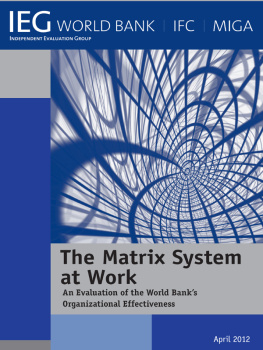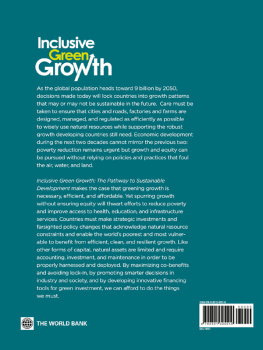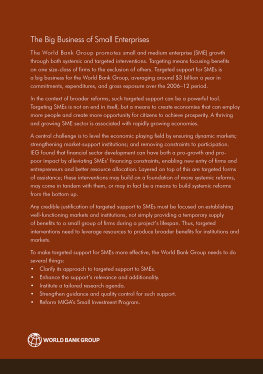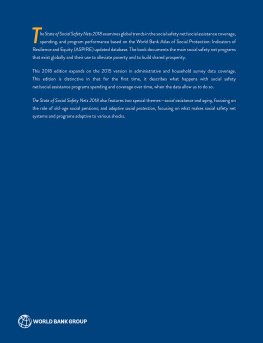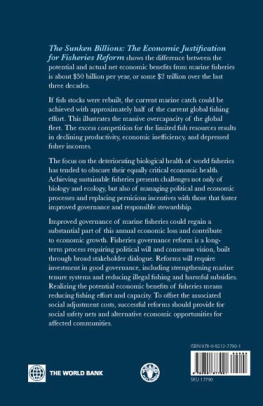Cover
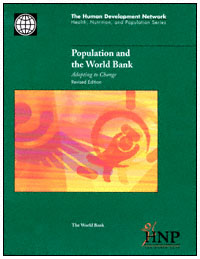
Health, Nutrition, and Population Series
This publication was prepared by the Health, Nutrition, and Population division (HNP) of the World Banks Human Development Network. HNP publications provide information on the Banks work in the sectors of health, population, and nutrition They consolidate previous papers in these areas, and improve the standard for quality control, peer review, and dissemination of HNP research.
The publications expand our knowledge of HNP policy and strategy issues through thematic reviews, analyses, case studies, and examples of best practice. They focus on material of global and regional relevance.
The broad strategic themes of the publications are proposed by an editorial committee, which is coordinated by Alexander S. Preker. The other members of this committee are A. Edward Elmendorf, Mariam Claeson, Armin H. Fidler, Charles C. Griffin, Peter F. Heywood, Prabhat K. Jha, Jack Langenbrunner, Maureen A. Lewis, Samuel S. Lieberman, Milla Mclachlan, Judith Snavely Mcguire, Akiko Maeda, Thomas W. Merrick, Philip Musgrove, David H. Peters, Oscar Picazo, George Schieber, and Michael Walton. |
| title | : | Population and the World Bank : Adapting to Change Health, Nutrition, and Population Series |
| author | : |
| publisher | : | World Bank |
| isbn10 | asin | : | 0821346636 |
| print isbn13 | : | 9780821346631 |
| ebook isbn13 | : | 9780585377933 |
| language | : | English |
| subject | World Bank, Population, Population policy. |
| publication date | : | 2000 |
| lcc | : | HB849.4.P673 2000eb |
| ddc | : | 304.6 |
| subject | : | World Bank, Population, Population policy. |
Page i
 | The Human Development Network
Health, Nutrition, and Population Series |
Population and
the World Bank
Adapting to Change
Revised Edition

Page ii
Copyright 2000
The International Bank for Reconstruction
and Development/THE WORLD BANK
1818 H Street, N.W.
Washington, D.C. 20433, U.S.A.
All rights reserved
Manufactured in the United States of America
1 2 3 4 5 04 03 02 01 00
The findings, interpretations, and conclusions expressed in this paper are entirely those of the author(s) and should not be attributed in any manner to the World Bank, to its affiliated organizations, or to members of its Board of Executive Directors or the countries they represent. The World Bank does not guarantee the accuracy of the data included in this publication and accepts no responsibility for any consequence of their use. The boundaries, colors, denominations, and other information shown on any map in this volume do not imply on the part of the World Bank Group any judgment on the legal status of any territory or the endorsement or acceptance of such boundaries.
The material in this publication is copyrighted. The World Bank encourages dissemination of its work and will normally grant permission promptly.
Permission to photocopy items for internal or personal use, for the internal or personal use of specific clients, or for educational classroom use, is granted by the World Bank, provided that the appropriate fee is paid directly to Copyright Clearance Center, Inc., 222 Rosewood Drive, Danvers, MA 01923, U.S.A., telephone 978-750-8400, fax 978-750-4470. Please contact the Copyright Clearance Center before photocopying items.
For permission to reprint individual articles or chapters, please fax your request with complete information to the Republication Department, Copyright Clearance Center, fax 978-750-4470.
All other queries on rights and licenses should be addressed to the World Bank at the address above or faxed to 202-522-2422.
ISBN 0-8213-4663-6
Library of Congress Cataloging-in-Publication Data has been applied for.
Page iii
ABOUT THIS NOTE
Why was this note prepared?
This note builds on the Banks Health, Nutrition, and Population Sector Strategy, which was discussed by the Banks Executive Board and management in 1997. The Board requested further discussion of how the principles and recommendations of the HNP strategy would be applied in the Banks work on population and reproductive health. This report addresses this request, with a particular focus on how the Bank is responding to the new approaches to population called for by the 1994 International Conference on Population and Development (ICPD) and to the changing demographic realities in borrower countries on which ICPD is based. A second generation HNP strategy will take stock of implementation progress and implications for going forward, including resource requirements.
Who is it for?
This note is written for two audiences. As was the case for the HNP sector strategy, the first audience is the Banks Executive Directors, management, and staff. The second, once the internal need is met, is external: the countries and partners with whom the Bank works.
How was it developed?
The note was prepared by a team of Bank staff working in the population and reproductive health fields under the guidance of the HNP Sector Board. There was extensive consultation with members of the Banks HNP family during the drafting process, and with others inside and outside the Bank once the initial draft was completed. Members of the Banks HNP External Advisory Committee reviewed drafts of the note and provided valuable guidance during their March and October 1998 meetings. The note was discussed by the Banks Board Committee on Development Effectiveness in March 1999 and again in February 2000.
How does it relate to regional and country strategies?
Unlike the education and HNP sector strategies, this note is not a full strategy. Rather, it provides a fuller explanation of how the recommendations of those strategies will be applied in the Banks work in population and reproductive health. The note also presents a strategy matrix summarizing how this work is to be done. Specific attention is given to ways of bringing a population perspective into Country Assistance Strategies and other key strategic documents. While the note draws selectively on regional views and evidence, it does not address all of the regional and country-specific issues that would be required at those levels.
What other considerations were taken into account?
The note is not a policy, research, or best-practice paper. In addition to the HNP sector strategy, it also draws on earlier Bank work in population and reproductive health, including Population and Development: Implications for the World Bank
Next page

